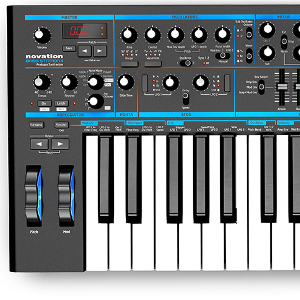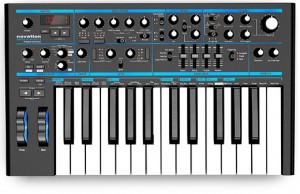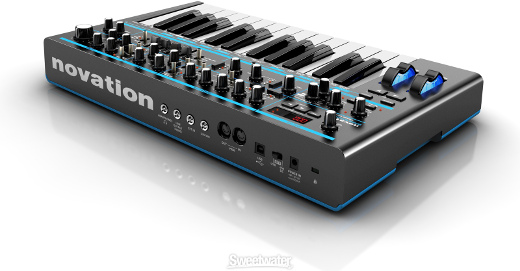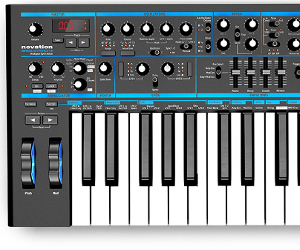Review: Novation Bass Station II — Analog Mono Synth
Consumers have always had a way with swaying the tides of trends, encouraging producers, designers, developers and manufacturers to reproduce what can now only be referred to as legendary or classic. We hear it in our music, see it in our vehicles and surprise, even in our films.
Novation has responded to their users’ demands by bringing back an updated version of one of their most hailed synths to date – and on their 21st birthday, no less. Allowing twenty years for technology to incubate, the Bass Station II marks the return of a classic mono-synth with just enough of the modern synth that produces the makings of something great.
Overview
Analog synthesis has been seeing a heavy resurgence in recent years through software emulation and hardware recreation because analog sound makes a compelling comparison against their digital counterparts – some may even argue that analog just sounds best. One thing digital has had an advantage over analog though, is its control capabilities.
You’re Hot When You’re Cold
The original Bass Station was released by a nascent Novation in 1993, and stands as a classic synthesizer today. Now in 2013 Novation brings the Bass Station II to us with its analog roots still very intact, encouraging a deeper experience with the integrated digital controls and features. The control offers the best of the digital world with patch recall, LFO syncing (internal or external clock), modulation assignments and more.
Right off the bat, the re-worked synth is ready to go with 70 factory presets that can be easily scrolled through. The presets show a well-rounded example of what exactly the Bass Station II is capable of because although they are few in number, they do express all of the new features from the arpeggiator to a variety of modulation options.
The layout of the Bass Station II is very easy to navigate and the clearly-marked mixer section makes it easy to start building basic tones without adding too much right off the bat.
Its compact 25-key footprint will take up very little space considering the control options it has to offer. This is mostly due to the introduction of new On-Key Functions that leave more core controls on the surface and leave more complex features under the hood. Think of the On-Key function like holding the function button on a computer keyboard with each of the 25 keys triggering different features.
The Layout
Like most synths out there, the Bass Station II uses subtractive synthesis to sculpt its sounds. The original Bass Station was so named because, as you may have guessed, it was typically used to produce a variety of bass lines. Nothing too complex though, given its minimal layout and synth engine.
There is no exception with its predecessor now except that the new bass sounds can range from subtle to earthshaking, spewing out tons of harmonic content with the new synth engine design. Not only that, but this thing can crank out cutting leads that play nice with the built in arpeggiator…almost too nice.
Here is a basic layout of the new Bass Station’s all-analog signal flow:
Oscillator 1(controls Sub Oscillator)/Oscillator 2 –> Mixer (Noise, All Oscillators, Ext. Input) –> Filter –> Effects –> VCA
Keep in mind that this is very simplified, and throughout this signal flow is the flexible modulation system among other features.
Now, lets take a stroll through the different sections of the Bass Station II and see how users can sculpt their sounds with current and new features. If this bores you, click here!!
Oscillation – You’re Up, Then You’re Down
The two main oscillators include four variable wave-forms: Sine Wave, Triangle Wave, Sawtooth and Squarewave with pulse width variation. It’s worth mentioning here that the pulse width can be modulated with either an LFO or the Modulation Envelope. The oscillators have standard pitch control that can also be modulated.
A cool feature offered by the main oscillators is Oscillator Sync, where Osc 1 acts as a Master, re-triggering the cycle of Osc 2 every time it begins a new cycle itself. This feature can add new harmonic qualities to the sound for a wider variety of tonal options.
The Sub Oscillator is the new kid on the block, bringing the earthshaking sound that will indeed carry on the “Bass Station” legacy. The Sub Osc includes three different wave types: Sinewave, Narrow Pulse Wave, and Square Wave. Users can choose between one or two octaves below Osc 1.
Mixer – You’re In, Then You’re Out
This is a section that offers a surprising amount of sound sculpting capabilities to the output of the Bass Station II. In the Mixer, users can gather their levels between Osc 1, Osc 2 and the Sub Osc. A fourth pot controls three switchable function amounts to be applied to the overall sound: Noise Generator, Ring Modulation, and External Input…this is actually used to control any external signal through the rear of the BSII for the incoming signal to utilize the analog filter and effects section. NEAT!
Here is an example of that with electric guitar:
Filter Section
Ah, the filter section, many-a-user’s impulse tweak. For the size, the filter section offers a lot of flexibility when coupled with modulation of an LFO or with the Mod Envelope .
• Fun Fact: The secondary filter mode, “Acid Filter”, is modeled on a classic diode ladder filter design – the same style of filter made popular by Moog. Squelchy, acidic goodness.
Their “Classic” filter is based off of the original bass station and offers Low, Band and High Pass filter modes. Each mode can be toggled between a 12dB and 24dB slope. The Filter section also offers pre-filter Distortion control. And, lest we forget, Resonance control is made directly available for both filter styles with a dedicated pot.
Now Featuring…Features!
Without getting too into detail about how some of the new features work and where in the signal flow they are located, I’ll take a moment to say what is new and what I liked about some unique sections that set the BSII apart..
Arpeggiator & Sequencer
There are a number of features in the Arp section that make creating arp sequences an inspiring process. The patterns can be as simple as one needs them to be – with 32 built in arp sequences that increase in complexity as the pattern number increases, tempo can be arranged from 40 BPM to 240 BPM.
Once these basic starting points are figured out, then comes the different modes and octaves users can choose from.
Additionally, the same section offers a 32-step Sequencer with four memory locations. The sequences are even stored within the patch locations if one so desires.
On-Key Functions
The On-Key Functions are a series of tools that allow for deeper integration into…well, function rather than the sonic character of the sound.
While we’re still on it, one of my favorite functions is the SEQ Retrig. This handy function will make users look good in front of the fans — more specifically, those that can’t quite match up their recorded sequence to the length of the selected Rhythm pattern. It simply cuts the sequence short so that it will match the Rhythm! Thanks Novation!
A few others that I can appreciate are the LFO Keysync and LFO Slew On-Key Functions. Firstly, LFO Keysync is yet another tool that the listening public will be impressed with – rather than having an LFO run wild at the stroke of each key, this function ensures the LFO will restart each time note is played. Useful in many situations.
The other feature I found surprisingly interesting is the LFO Slew function. I had mentioned earlier that all of the On-Key Functions didn’t affect the sonic characteristics of a sound on the BSII, but this may actually be the one exception depending on the amount applied. Slew actually increases the amount of time it takes the selected LFO waveform to reach maximum amplitude by basically rounding the edges out. Think of a square wave slowly gaining sine wave characteristics or a triangle wave becoming increasingly rounded at its peaks.
Hands On
Like all hardware synths, the Bass Station II was very inspiring to work with. The one thing I have always liked about hardware instruments as opposed to virtual instruments is the direct availability of each function. Ease of access is key in getting caught in a creative storm and the BSII accomplishes this very well.
Everything on the BSII is well laid out and clearly marked to help with signal flow and navigation – something beginners will always find very useful. The pots, sliders and switches are all very solid and make it easy to dial in just the right amount of character. The keys are also sturdy with a retro, spring action feel.
On top of all of the great functionality, Novation brought back some great aqua blue character back and a really cool all blue undercarriage. This BSII has just the right amount of style to attract all the hip guys and gals.
A Dip In The Design
A synth with this kind of functionality vs. price point can be difficult to nit-pick. But if I didn’t force myself to find something wrong, then everything I’ve ever toyed with would be “PERFECT”!
One thing I have really liked with digital control is how easy patch recall, documentation and visibility can be. Although Novation does include some sort of effort by displaying the numerical value when a parameter is tweaked, there is no way of telling otherwise. Then again, most affordable synths are laid out this way. Although my favorite layout, visually, has to be Moog.
Just one other issue I can’t seem to get over is the fact that, brace yourselves, the Bass Station II only has MONO line out! No stereo folks. No stereo effects. Nothing stereo. I had imagined myself programming a modulating distortion in the heat of the night. Maybe next time, Gabe. Maybe next time.
The Bottom Line
Novation awarded the world of musicians with the re-creation of one of their most famous synths ever. The Bass Station II brings a modern twist to their popular retro bass machine by staying intact with its roots and adding future functionality. Not to mention a pretty rad color scheme.
Sounds from the new synth engine are very dynamic and bring a new character to the synth scene. I can’t seem to stop playing with the arpeggiator!
But, I digress.
For $629.99 MSRP/$499.99 street, this synth is an absolute must buy: If there is one mid-range synth that you have been holding out on for this price point, I would recommend giving the Novation Bass Station II a deep look. There isn’t a single parameter or value on the synth that users won’t eventually use time and time again. Thank you for continuing the Bass Station legacy, Novation.
Please note: When you buy products through links on this page, we may earn an affiliate commission.











Scott Wozniak
October 30, 2013 at 2:02 pm (11 years ago)“Fun Fact: The secondary filter mode, “Acid Filter”, is modeled on a classic diode ladder filter design – the same style of filter made popular by Moog.”
This is wrong. The “acid” filter is based on the Roland TB-303, not a Moog.
rob
October 30, 2013 at 3:18 pm (11 years ago)it’s a BASS station, of course it’s mono! bass is never not meant to be mono.. use a pedal if you -must- stereoise the midrange i guess but i would imagine it would cost a fair deal more with those features and thats why they made that decision. otherwise pretty nice review, i had a good poke at one of these the other day, the immediacy and simple but flexible routing/programming had me grinning heavily in the music store.. (friend) “are you done yet?” (bass station) VRRRRRREEEEEOOOOOOOWOOWOOWOOWOOWOO (sales assistant): “he doesn’t sound too done..” don’t know if i ever would’ve been haha
Gabriel Lamorie
October 30, 2013 at 6:04 pm (11 years ago)Scott, you are right. I had initially been reminded of the Moog after initial demoing. Thanks for informing us!
– Gabe Lamorie
Gabriel Lamorie
October 30, 2013 at 6:09 pm (11 years ago)Thanks for the insight Rob! Very true – bass is always better mono. But the capabilities of the BSII inspired my thinking to stereo and beyond! Then I got back to routing and my transgressions happily subsided…Thanks for checking out the review!
– Gabe Lamorie
Blip
October 31, 2013 at 3:26 pm (11 years ago)Being a Bass station does not mean you are obliged to make only bass sounds with it… but I do agree with you about the cost decision.